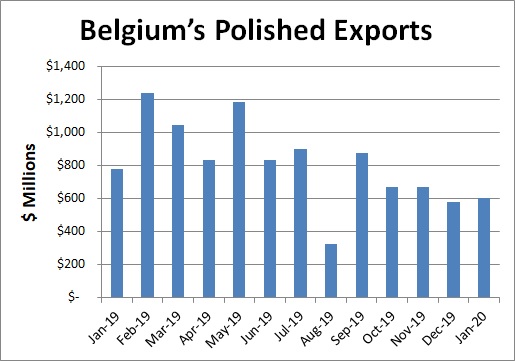RAPAPORT... Belgium’s polished exports dropped 22% year on year in January, with volumes and average price both falling. Outbound shipments have declined for nine consecutive months, according to Rapaport archives based on data from the Antwerp World Diamond Centre.
However, rough imports showed their first monthly increase since December 2018, as post-holiday restocking was stronger than a year earlier. Mining companies’ January results reflected this improvement, with both De Beers and Alrosa reporting growth in rough sales.
| Belgium Trade Data for January 2020 | ||
| Jan 2020 | Year-on-year change | |
| Polished exports | $605M | -22% |
| Polished imports | $750M | -20% |
| Net polished exports | -$145M | Deficit decreased 13% |
| Rough imports | $829M | 14% |
| Rough exports | $691M | -7% |
| Net rough imports | $139M | 2019: Deficit of $18M |
| Net diamond account | -$284M | Deficit increased 91% |
| Polished exports: volume | 299,467 carats | -6% |
| Average price of polished exports | $2,022/carat | -17% |

Source: Antwerp World Diamond Centre; Rapaport archives
About the data: Belgium is usually a net exporter of polished diamonds. As such, net polished exports — representing polished exports minus polished imports — will normally be a positive number. The nation is also a net exporter of rough. While Antwerp is home to some high-value manufacturing, its main role in the market is as a facilitator of rough-diamond trading, with companies from around the world coming to the city to buy rough. The net diamond account is total rough and polished exports minus total imports. It is Belgium’s diamond trade balance, and shows the added value the nation creates by exporting rough or manufacturing it into polished.
Image: The diamond district in Antwerp. (AWDC)
Source: Rapaport 3-3-2020